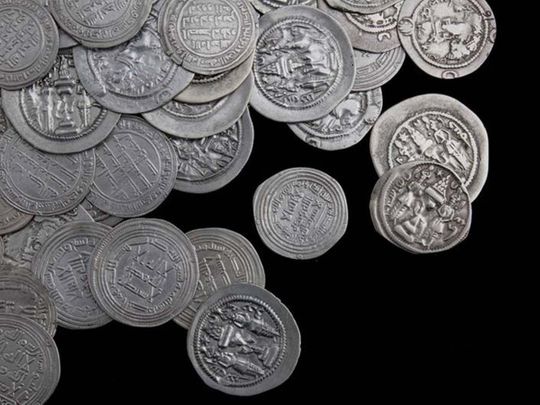Rare early Islamic silver coins on display in the Louvre Abu Dhabi from tomorrow
[ad_1]
The set of more than 2,861 coins pertaining to the reign of King Shapur II (A.D. 309-379) and up to the reign of the Abbasid Caliph Al Ma’mun (A.D. 813-833) Image for illustration only.
Image source: Courtesy: DCT Abu Dhabi
Abu Dhabi: A rare collection of silver coins from the early Islamic civilization – the hoard of Jazira – will be on display at the Louvre Abu Dhabi tomorrow.
The set of more than 2,861 coins pertaining to the reign of King Shapur II (309-379 AD) and up to the reign of the Abbasid Caliph Al Ma’mun (813-833 AD) was held by the museum in Abu Dhabi acquired. It is exhibited together with 67 other individual gold or gold alloy coins that were produced in the Mediterranean and Eurasia between the 6th and 16th centuries.
In a statement, the Louvre Abu Dhabi said the “coins reveal the regional and local history that signify political changes, power struggles and the changing values ​​of precious metals during these periods”.
Monetary history
“This display will show a global monetary history. It illuminates the trade, cultural exchange and political dynamics that a networked world economy reveals between distant regions. It bears witness to the birth of Islamic coinage and its development. The Sassanid drachmas, Umayyad dirhams, Abbasid silver coins, alongside the Byzantine gold solidus, Genoese and Venetian gold coins and more will prove how a simple coin can exemplify power relations and rivalries between competing, growing empires as well as the emergence of major trading centers, â€said Guilhem Andre, the museum’s chief curator.
Careful conservation
The collection is named after the minting area of ​​the coins: the jazira or island loosely refers to Upper Mesopotamia, which today includes northwest Iraq, northeast Syria and southeast Turkey. The Louvre Abu Dhabi had previously reported that the collections had been acquired by a private collector in Europe.
“Coins documented and digitized”
Theofanis Karafotias, the museum’s head of preventive conservation, said an extensive conservation process had been carried out prior to the public exhibition.
“The coins were not only preserved by the museum, they were also documented and digitized so that they could be examined more closely. We also had to decide how to preserve each of the thousands of coins, such as whether chemicals, an ultrasonic bath or a simple treatment with distilled water would be the best solution – the least intrusive way of showing the face of each coin, â€he explained.
The craftsmanship, minting and minting of coins were inherited from the Byzantine and Sassanid empires, and this treasure testifies to this transition period. The coinage of the Byzantine and Sassanian empires had representations of the divine, but this was a way for the Islamic rulers to tie their political and religious power to the currency by changing it.
– Souraya Nujaim, Director of Scientific, Curatorial and Collection Management, Louvre Abu Dhabi
Financial centers
The unveiling of the new presentation is dedicated to the financial centers and their monetary systems that emerged in the Middle Ages. The proliferation of certain gold and silver coins and the trade in precious metals set the stage for the economy of the modern world, a practice that later had a significant impact on the world economy. The new display will therefore illuminate the transcontinental trade in gold and silver. The stylistic development of these coins also serves as an indicator of their performance in accordance with time and changing geographies.
The Louvre Abu Dhabi also has a number of other coins in its numismatic collection, with many valuable pieces on display in a dark room. Carefully lit showcases present the coins, which date back to ancient Greece and China.
Importance of the collection
Speaking to an international media company about the coin treasure, Souraya Nujaim, director of scientific, curatorial and collections management at the museum, said that “it is extremely rare to acquire so much undocumented history”. She added that the coins represented the changing face of trade in that era, a consolidation largely attributed to Abdel al-Malik, the fifth Umayyad caliphate who also introduced major changes to the visual symbols on the coins and AD 693 A uniform Islamic currency was created.
“The craftsmanship, minting and minting of coins was inherited from the Byzantine and Sassanid empires, and this treasure shows this transition period. The coinage of the Byzantine and Sassanian empires had representations of the divine, but this was a way for the Islamic rulers to tie their political and religious power to the currency by changing it, “she explained.
Preservation and recording
The museum’s restorers recorded the weight, diameter, and thickness of each coin and photographed the front and back of each coin before starting the restoration. This can also help historians understand how coinage evolved and how metal combinations have changed in coinage over time. In addition, it helps to understand the use of various symbols and images in coinage, including the portraits of rulers, names of rulers, and even texts from the Holy Quran.
Karafotias said that although the coins are considered silver, they also contain some copper in their composition, which is easily corroded.
“Humidity and temperature both affect the rate of corrosion. Sulfur, fossil fuels, paint, wood, felt – all of these can have an impact on corrosion. Another factor is inadequate pre-treatment, â€he explained.
These details are placed in an international database so that museums and other collectors can compare them with other pieces.
[ad_2]

